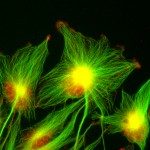Lien vers Pubmed [PMID] – 25293574
EMBO J. 2014 Dec;33(23):2745-64
Actin dynamics drive morphological remodeling of neuronal dendritic spines and changes in synaptic transmission. Yet, the spatiotemporal coordination of actin regulators in spines is unknown. Using single protein tracking and super-resolution imaging, we revealed the nanoscale organization and dynamics of branched F-actin regulators in spines. Branched F-actin nucleation occurs at the PSD vicinity, while elongation occurs at the tip of finger-like protrusions. This spatial segregation differs from lamellipodia where both branched F-actin nucleation and elongation occur at protrusion tips. The PSD is a persistent confinement zone for IRSp53 and the WAVE complex, an activator of the Arp2/3 complex. In contrast, filament elongators like VASP and formin-like protein-2 move outwards from the PSD with protrusion tips. Accordingly, Arp2/3 complexes associated with F-actin are immobile and surround the PSD. Arp2/3 and Rac1 GTPase converge to the PSD, respectively, by cytosolic and free-diffusion on the membrane. Enhanced Rac1 activation and Shank3 over-expression, both associated with spine enlargement, induce delocalization of the WAVE complex from the PSD. Thus, the specific localization of branched F-actin regulators in spines might be reorganized during spine morphological remodeling often associated with synaptic plasticity.

